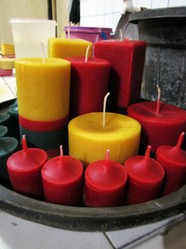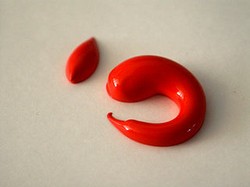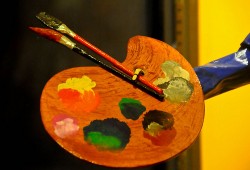Candle-making is a fun craft to do. Not only is making candles a potential money-making business; candlemaking is also an outlet where you can unleash your artistic creativity. Do you want to make candles? Get to know the candle-making supplies you need to start making candles. Here is an elaborate list of your candlemaking supplies.

16 Candle-making Supplies and Equipments to Make Candles
Candle-making is a fun craft to do. Do you want to make candles? Get to know the candle-making supplies you need to start making candles.
Candle Wax
Wax is the main candle material that makes up your finished candle. It is the wax that, rising up the tip of the wick, fuels the flame of a candle. There are different types of wax for candle-making. The most commonly used candle-making wax is paraffin, produced from petroleum. You may also choose as your ingredients beeswax or soy wax, which are softer candle wax supplies, used mostly in container candles. If you want hard wax candle-making supplies, palm wax from Southeast Asia is a tough wax and comes in wonderful patterns. You don’t need a particular kind of wax to make a hard candle though; an additive can harden an otherwise soft wax.
Candle Wick
Wick is the candle-making supply that you see right in a finished candle. There is no such thing as a wick-less candle. Without a wick, your candle is just a block of wax that wouldn’t burn. There are several kinds of wick to include in your inventory of candle-making supplies. Flat wicks are the least costly. Cored wicks are more expensive, but with added value to your candle. Cored wicks are also made of cotton, but with a core in the middle that keeps the wick upright, instead of wilting like ordinary cotton wicks do. The core may be nylon, zinc or paper.
Candle Mold
Unless you are making candle in a container, through dipping, or with the use of alternative implements to give your candle shape, you would need a candle mold as one of your candle-making supplies. Candle molds come in different sizes, shapes and materials. Metal candle-making molds are ideal in modern candlemaking. A candlemaker may, however, opt for clay molds, especially since the chandler can make a candle mold of his own design using clay, plaster of Paris, or other similar material.
Candle Dye
Unless you want your candle as white or transparent as the original wax, dye would be among your candle-making supplies. Candle dyes come in powder, chips and liquid. Red, blue and yellow are well within your choices of candle dye. If what you want to make are white candles though, you don’t need dye for your candle materials. Do you like you candle whiter than the wax you are using? The candle supply that you need is an additive.
Wax Additives
Additives are candle-making supplies that don’t necessarily burn like the candle wax, but merely change a candle’s hardness or opacity. Of these candle-making materials, crystal wax is an additive mixed with candle wax to harden it. Polyethylene toughens a candle too, but is especially used to increase a candle’s whiteness. On the other hand, microcrystalline wax is mixed with candle wax when a candle-maker wants to produce a wax that is soft and malleable, allowing the wax to be bent and molded into shapes as it dries. Mixtures of several additives in one ingredient are also among the available supplies for candle-making.
Essential Oil
If you like your candle to cast fragrance as it burns, you will have to include essential oil in your shopping list of candle-making supplies. Essential oils are oils extracted from plants. The oil retains the plant’s aroma. There are numerous scent supplies for making candles. Therapeutic lavender is a popular choice of scented candles, while insect-repellant citronella is prized for keeping mosquitoes away.
Wick Holder
When you are making container candles, wherein you pour your wax into containers like glass or jars, it is best to have some wick holders among your candle-making supplies. A wick holder, also known as wick anchor, is a small metal coin or tube that you attach to the bottom tip of your wick to keep it in place. Wick holders are not necessary when you are using candle molds, because your wick passes right through the bottom of the mold, and therefore needs not be anchored.
Laboratory Thermometer
Small, seemingly negligible apparatus, but a thermometer is quite an essential tool when making candles. You don’t pour wax into your candle mold at just any temperature, and the thermometer enables you to keep track of the temperature of your candle wax. You don’t have to keep a stock of thermometers in your candle-making supplies. You only need one thermometer — unless you’re using several pouring pitchers or kettles.
Kettle
It is ideal to use kettle when pouring wax into the candle mold. The small spout of the kettle makes it easy for you to pour wax well within the candle mold, without sloshing the sides of the mold, which may spoil the outcome of your candle. If you are mixing more wax than a kettle can contain, you may want to consider buying a huge pouring pot in addition to your candle-making supplies.
Pouring Pot
A pouring pot, also known as pouring pitcher, is a pot with a lip for pouring. You can mix your wax in the pouring pot, and just transfer the dyed and scented wax mixture into the kettle for pouring. Of course, you may choose to do away with the kettle as one of your candle-making supplies altogether, and just pour wax into your candle mold straight from the pouring pitcher. It’s not the same story though when you’re using several colors in one candle, in which case you can conveniently melt the wax in the pouring pot, and add the respective dyes and scent only after pouring the wax into several kettles.
Weighing Scale
Unless you’re using one kind of wax and that wax alone, without additive or scent, the weighing scale is an essential item in your candle-making supplies. When you get into actual candle-making, you’ll find that for best results you need to mix wax, additives and essential oil in a certain proportion. This is where the handy-dandy scale comes in. You weigh your wax, weigh the additives you’re going to mix with the wax, and determine how much aroma you are putting into the mixture using the weighing scale.
Double Boiler
Use of double boiler in melting wax is optional, but is recommended for utmost safety. Wax is flammable material. You should never leave a melting wax over a heat source unattended, and you should never melt candle wax to the point that it boils — the evaporating wax might catch a flame, and you got yourself a potential disaster. A double boiler relieves the risk of house fire, since it slows down the rise of wax temperature, which is also the downside of the measure. It would take you longer to melt wax in a double boiler than directly over a heat source. In the end, if you attend to your wax in the stove every minute, you don’t really need to squeeze in the double boiler among your candle-making supplies; you just need to be careful and attentive.
Stove or Hot Plate
How can we forget the heat source? We cannot melt wax without it. You don’t have to buy brand new for your candle-making supplies though. Your existing kitchen stove will do. Better yet, use a hot plate. Making candles is a messy business, and it’s easier to clean spilled wax off a hot plate after your candle-making session than off the stove top.
Butter Knife
If you’re using blocks of paraffin wax, not pellets, a simple butter knife will do the job of slicing those blocks into sizes that fit into the pourer for melting. If you feel that sawing wax with a small, dull butter knife is quite tedious, you could always resort to breaking the slabs of wax into smaller pieces with the back of a butcher knife. Hammer away, comrade.
Wick-centering Device
A wick-centering device helps keep your wick at the center of the mold or container. Some candle molds come with a similar tool. If you’d rather spend money on other candle-making supplies than over fancy wick-centering devices, you can use barbeque stick. Split the barbeque stick down the middle up to half its length, clip the tip of the wick in it, and you’re good to go.
Heat Gun
You don’t need a heat gun to make candles, but a heat gun comes in handy when, upon pouring wax into the mold, you inadvertently slopped wax around the side. Aim the heat gun at the slop from outside the candle mold, and let the sloshed wax melt from the blast of the heat gun and fall into the rest of the wax. A heat gun becomes necessary equipment in your candle-making supplies when you decide to package your candles in shrink wrap. The heat gun does better job of shrinking the plastic than a blower, if a hair blower even works.
Ready to make candles?
Candle-making can be a fun business and productive hobby. You can make candles to gift to friends, sell, or just express your art and personality. The craft requires candle-making supplies and equipments though. You don’t really have to buy all the candlemaking supplies; you may purchase only those candle supplies that you positively need. You could also improvise. Candle-making is a highly creative craft, even in the manner that it’s done.
About the Author
Deomar Pandan is a visual artist, online writer and jeweler. He recently launched kamayojewelry.com, and is the artist behind the jewelry items shown in the website.
You might also like
The 11 Different Visual Art MediaThere is an art medium for every artist, the one that he’d love and make mast...
12 Art Supplies and Materials for Painting with Acrylic PaintPainting with acrylic paint can be very rewarding. Want to paint with acrylic...



















 What Camera to Buy: Compact, Digital SLR or just Phone Camera?on 03/06/2013
What Camera to Buy: Compact, Digital SLR or just Phone Camera?on 03/06/2013
 The 12 Best Scents and Essential Oils from the Philippineson 02/18/2013
The 12 Best Scents and Essential Oils from the Philippineson 02/18/2013
 12 Art Supplies and Materials for Painting with Acrylic Painton 02/15/2013
12 Art Supplies and Materials for Painting with Acrylic Painton 02/15/2013
 The 11 Different Visual Art Mediaon 01/22/2013
The 11 Different Visual Art Mediaon 01/22/2013



Do you like to make candles?
Hello, EXCELGENON. You'd best be buying those candle molds online. Try eBay or Amazon.
Hello Deomar, would you happen to know where I can buy those metal candle molds here in PH?
Your welcome, sheilamarie. I've actually left out an item — cookie sheet, to make the bottom of the candle flat. But I don't feel like updating this article until it gets indexed by big G. :-)
Very comprehensive explanation of what a candlemaker needs to get going. Thanks, Deomar.
Hi, Hollie! Yep, candles make really good gifts; I've been gifting scented candles to friends on their weddings. There's a way around the mess. Just cover the work surfaces, tables and floor, with old newspapers — it'd be easier to clean up afterward.
I'd also like to get into candle making, I'd like to make gifts- scented candles appeal at the moment. I'm just trying to envisage the mess I would invariably make :) Still, worth it when you see the finished product.
You're welcome, Barb. Thanks for dropping by.